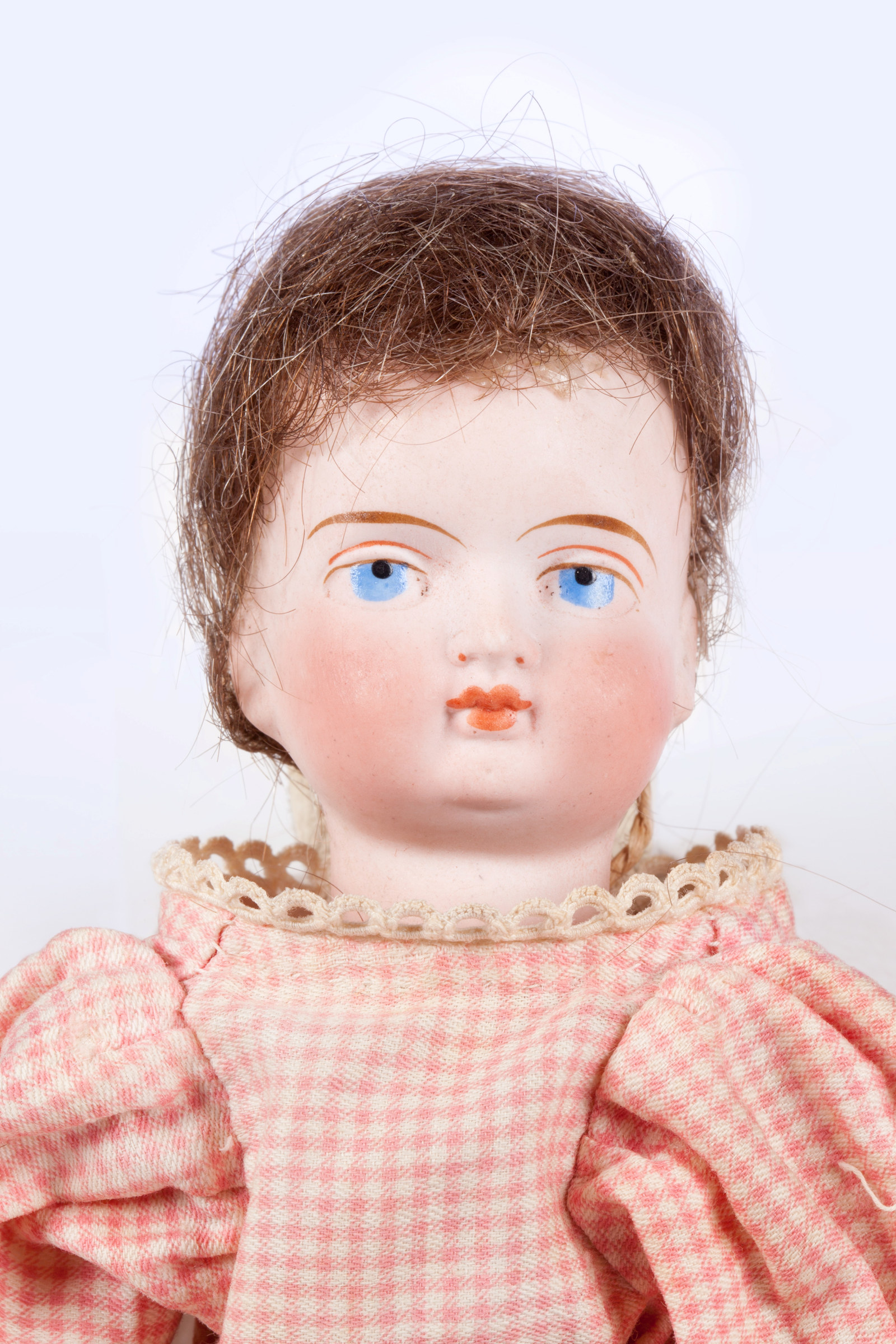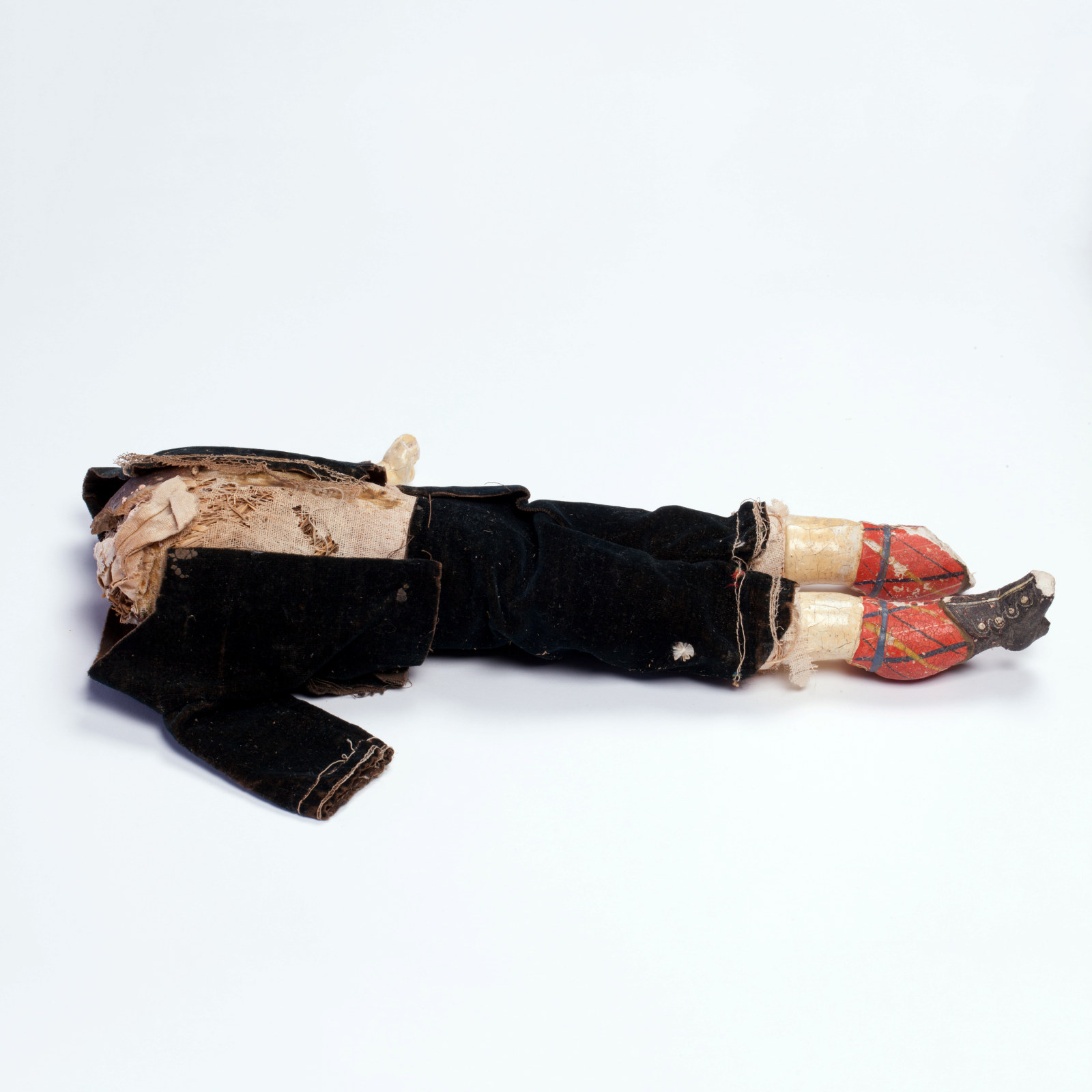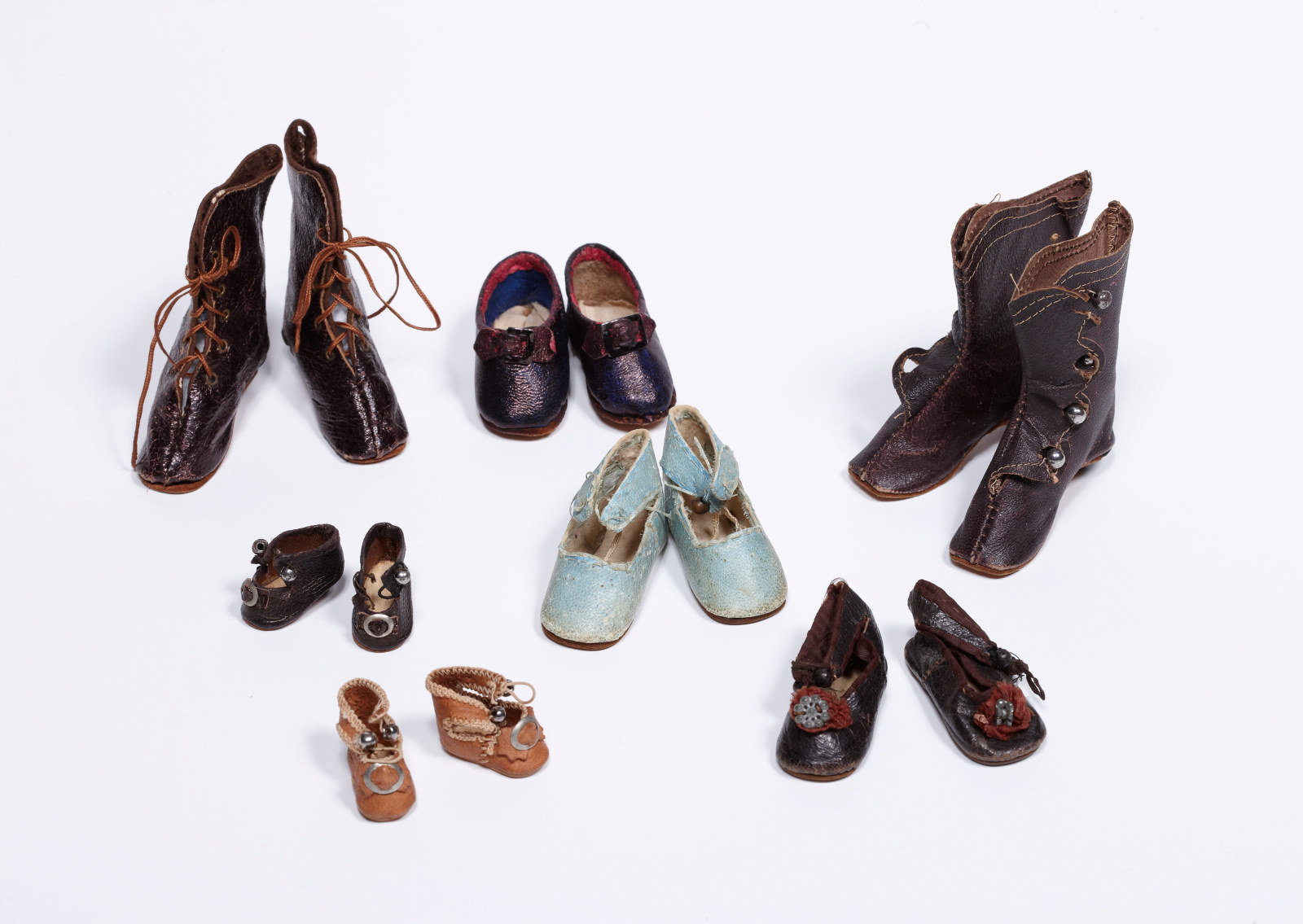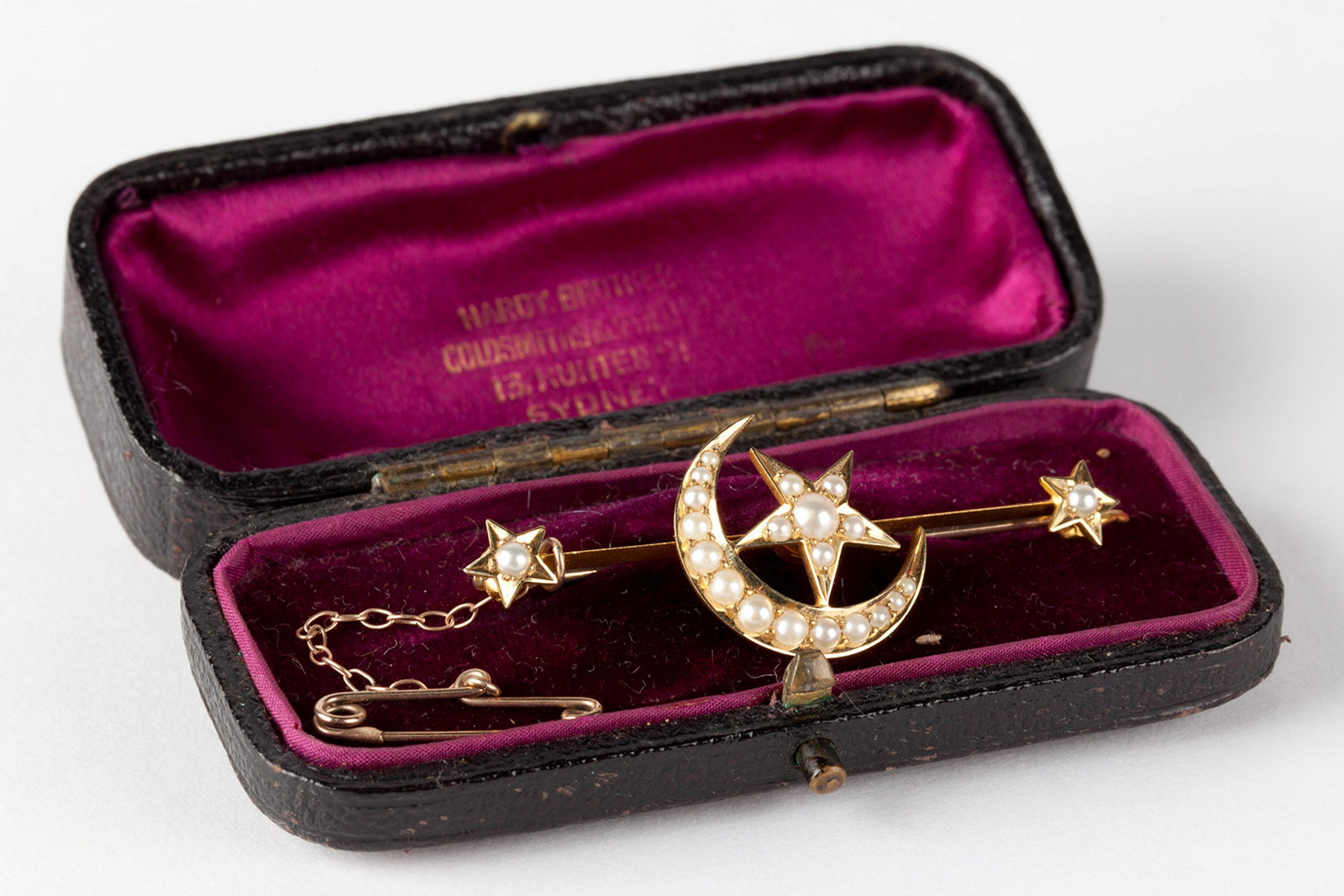Child's play
The imagination of a child can turn the simplest toy into a prized possession.
Kathleen Rouse created a world of her own from the dolls at Rouse Hill Estate; new characters were created with the help of a variety of dresses and accessories hand-made by Kathleen’s nurse, Mrs Cockram. Imaginative play extends to a range of other toys in the Museums of History NSW collections including alphabet blocks, a paper cut-out doll found under the floorboards at Hyde Park Barracks, more dolls and a child’s tea set at Meroogal and a spotted Indian deer pull toy at Elizabeth Farm.
A doll named Charlotte
This doll belonged to Charlotte Elizabeth Davis (1861-1939), born in Islington, London, the daughter of an innkeeper. Charlotte married Hermann Hicks in 1882 and in due course the doll was given to her eldest daughter, Dorothy Charlotte Hicks, born in London in 1883. Dorothy herself married Cecil Jolly in London in 1907 and the doll soon embarked on a series of sea voyages as Dorothy and her husband went first to India, where Dorothy’s own daughter Alison was born in 1909, then to Toronto, Canada, where her mother had settled, back to England in 1916, and finally to Australia. Charlotte the doll has a wax head, wax arms and legs and a cloth body. She has a wardrobe which includes a finely pleated and piped cream silk dress, knitted cotton socks and black leather shoes; a white cotton dress and an underbodice, drawers, chemise, petticoat, and an apron, two bonnets and a silk shawl – a young girl’s exemplar of the dressmaking arts.
A spotted deer from India
This enigmatic animal is a resin-cast replica of an early nineteenth century wooden (cedar) carved and painted toy that belonged to John & Elizabeth Macarthur's children at Elizabeth Farm, near Parramatta or, perhaps, to their grandchild at Camden Park. The original remains in the collection at Camden Park. The animal is probably a spotted deer or chital, indigenous to many parts of northern India, and the original toy is likely to be a product of the extensive hand-made wooden toy industry of Rajasthan. Brightly painted wooden or papier-mâché pull-along toys of elephants, tigers, camels, horses and a range of other animals were a celebrated product of the Rajasthani toy industry. Perhaps surprising, spotted deer were a common sight around colonial Sydney, first imported around 1803 by Surgeon John Harris. Within ten years he had around 400 spotted deer on his various properties including at his Ultimo estate. They were frequently hunted for sport by the gentlemen of the colony, though by the mid-19th century they were also sold as pets.
According to fashion
This tiny mustard-coloured silk satin doll’s dress is part of the extensive wardrobe of doll’s clothes made for Kathleen Rouse (1878-1932), the younger of the two daughters of Edwin and Bessie Rouse of Rouse Hill House. The clothes were made by Kathleen’s nanny Mrs Sarah Frances Cockram (c1849-1913) who came to Rouse Hill around 1880. A Freeman Brothers studio photograph of Kathleen and her older sister Nina, taken around 1883, shows one of Kathleen’s dolls wearing this dress with its distinctive pleated hem. The tiny ankle-strapped shoes worn by the doll also survive in the Rouse Hill collection. As well as the pleated hem, the dress features a tiny bustle and emulates a style made popular by fashion icon Princess Alexandra in the 1880s. There are other photographs in the Rouse family albums showing the sisters themelves wearing similar pleated dresses and even a carte-de-visite of Princess Alexandra in the same attire. Mrs Cockram’s other creations included a bridal gown comprising a cream silk satin bodice and separate skirt with train, beautifully trimmed with lace, artificial pearls and flowers.
Blue-coated rider
This blue-coated rider has lost his mount, or maybe he was purposely removed or just meant to be replaced with another rider. The blue-coated rider has also lost his owner – he was found during an archaeological excavation of Hyde Park Barracks, possibly slipping between the floorboards by accident, or pulled under deliberately by a rat. The blue-coated rider probably belonged to one of the 14 children of Lucy Applewhaite (later Hicks), the matron of the Immigration Depot and Hyde Park Asylum from 1861 to 1886. While most of the building contained dormitories for orphan girls, immigrant and asylum women, the Applewhaite family (and later Hicks when Lucy remarried) lived in the north western room of level 2, adjacent to where archaeologists found this doll over 100 years later. Paper cut-outs, sometimes adhered to sturdy card like this figure, were common objects of play for 19th century children. They might be used for imaginative play with just one or two other figures or as part of much larger staged sets involving casts of characters, props and theatre backdrops.
Child’s tea set
This English stoneware toy tea set was given to June Steel (later Wallace, 1917-2010) by her aunt Helen Macgregor around 1922 when June was five years old. June was born at the Presbyterian Manse in Young where her father was the Minister. After her parents’ marriage ended in 1921 she and her mother Margaret Steel (nee Macgregor) moved to Nowra where they lived with June’s grandmother Mary Susan Macgregor (nee Thorburn) at Kintore, a cottage built on the horse paddock of the Thorburn family house, Meroogal. June spent a lot of time with her Macgregor aunts and Thorburn great-aunts and often stayed at Meroogal where afternoon tea was an important social occasion. With her toy tea set, June undoubtedly enjoyed imitating her aunts. The toy tea service would also have helped her perfect the ritual of afternoon tea, considered an important skill for most middle-class Australian girls. June eventually inherited Meroogal and although she lived in Sydney, visited Meroogal and her Nowra friends regularly, maintaining the tradition of her aunts and great-aunts by beginning each visit with a cup of tea on the side verandah.
Cosy Cuties
These tiny 3.5cm bisque dolls belonged to June Mary Steel (later Wallace 1917-2010) and were given to her by her aunt Helen Macgregor in 1925. Their bodies are solid, their arms and legs are hinged by wires and their little faces are painted with a delicate pink blush, rosy cheeks and ruby lips. June was the only child of Margaret Ross Macgregor and James Barnet Steel and was born in Young where her father was the Presbyterian minister. The marriage failed when June was very small and she and her mother moved to Nowra where they lived with her grandmother Mary Susan Macgregor (nee Thorburn) at Kintore, a cottage built on the horse paddock of the Thorburn family house, Meroogal. June spent a lot of time with her Macgregor aunts and Thorburn great-aunts, learning to read, learning to knit and playing with her dolls. Her grandmother and her aunt Belle both knitted and crotched very finely and it’s probable that they made the miniature dresses worn by the dolls, along with the larger doll’s booties that June used to keep her miniatures cosy while stored in a re-used opticians’s box.

Hill’s Alphabet Blocks
The name ‘Kathleen B. Rouse’ has been hand-written inside the lid of this box of Hill’s Alphabet Blocks. The box comprises 27 timber tile-shaped blocks, one for each letter of the alphabet plus an ampersand, intended to help children learn their letters. The idea of alphabet blocks has been around since the late seventeenth century when English philosopher John Locke argued that ‘learning might be made a play and recreation to children’. He suggested that dice covered with letters on all six sides could be thrown as part of a game. By the 19th century this idea had become commercial. Kathleen’s blocks, in their wooden box with a sliding lid, were manufactured by S. L Hill of Williamsburg, New York who patented paper-on-wood spelling blocks in 1858. They were amongst the earliest alphabet blocks mass produced in the United States. These blocks, along with dolls and other toys, helped to fashion the imaginative childhood of Kathleen Rouse (1878-1932) at Rouse Hill House. Although the blocks were educational, they may have also acted as building blocks, helping to construct Kathleen’s world of childhood theatricals and pageants.

Kathleen’s blue eyed girl
This doll, with startling blue eyes and finely modelled and painted bisque head, belonged to Kathleen Rouse (1878-1932), the younger of the two daughters of Edwin and Bessie Rouse of Rouse Hill House. Kathleen had a particular interest in doll play, often staging grand pageants, weddings and funerals in the nursery at Rouse Hill and re-writing popular Victorian melodramatic novels to record the social life of her dolls. She even published these in a house journal called the Rouse Hill Gazette. This doll has led a vigorous, and slightly mysterious life. Her one remaining blue plaster leg is a match of sorts for her blue eyes but the scale and quality of her body, her plaster hands and especially her timber torso are not a match for the quality of her head. Her pink and white gingham dress, on the other hand, is well-made. Like most of the doll’s clothes at Rouse Hill House it was probably the work of Kathleen’s nanny Mrs Sarah Frances Cockram (c1849-1913), an adept seamstress who pieced the clothes together from remnants of household fabrics and trims.

The recycled bridegroom
This broken doll, missing its head, missing one arm and a foot, and with its sawdust stuffing on show, was once a fine gentleman named the Duke of Silversod. He was one of the childhood toys belonging to Kathleen Rouse (1878-1932), younger daughter of Edwin and Bessie Rouse of Rouse Hill House. Kathleen was a child with a vivid imagination, devising a series of pageants, plays and weddings in which her dolls featured as heroines and heroes. However, Kathleen’s collection of female dolls vastly outnumbered her one gentleman doll. This meant that his marriages were often short-lived before he was recycled as the bridegroom in another wedding. He clearly bears the scars of his service and his multiple identities, not only as the Duke of Silversod but also as Sir Reginald C. Churchill, among others. His painted tartan stockings indicate that his original costume was that of the Scottish ‘Highland boy’. His blue velvet suit represents another incarnation, one that was the height of fashion for boy’s formal wear after the 1886 English publication of Frances Hodgson Burnett’s novel Little Lord Fauntleroy.

Well shod
These dolls shoes are part of the collection of costume, toys and childrens’ books that relate to the childhood of sisters Nina (later Terry, 1875-1968) and Kathleen Rouse (1878-1932), the daughters of Edwin and Bessie Rouse of Rouse Hill House. Their dolls were both fashion mannequins and play things and replicated adult styles, with hats, shoes and accessories designed to match the array of dresses in the doll wardrobe. These boots and shoes are in keeping with styles of the 1870s and 1880s, when bustle skirts became the mode and their movement revealed the ankles when walking, while skirt fronts fell close to the body and allowed the front of shoes to become visible. Wearing boots became a fashionable way to maintain modesty by preventing the exposure of women’s ankles and shoes became increasingly detailed with punch-work, rosette embellishments, cutouts and button closures. Most doll’s shoes came from France in the 19th century and the little burgundy glacé kid leather shoes - with double rosettes and buttoned ankle straps - shown in this photograph are imprinted with a star, the word ‘Paris', and a tiny size ‘3’ on their soles.
Related

Baubles, brooches & beads
We wear jewellery as articles of dress and fashion and for sentimental reasons – as tokens of love, as symbols of mourning, as souvenirs of travel
Published on